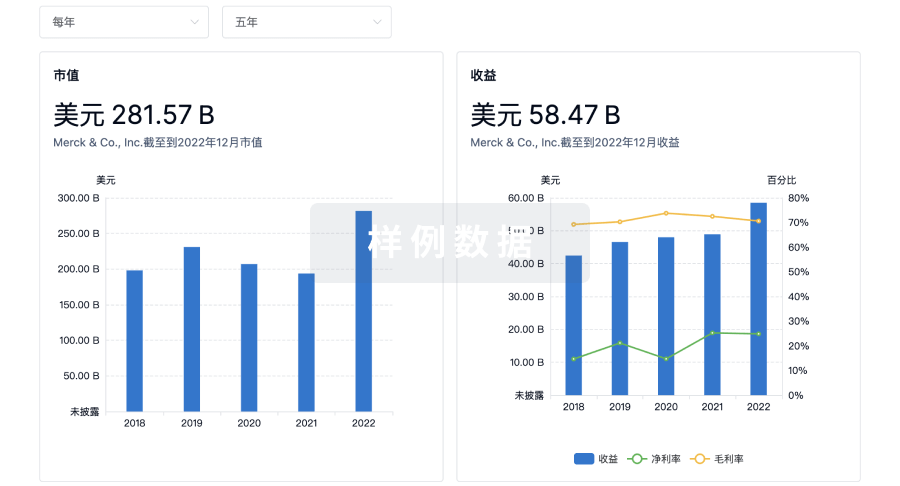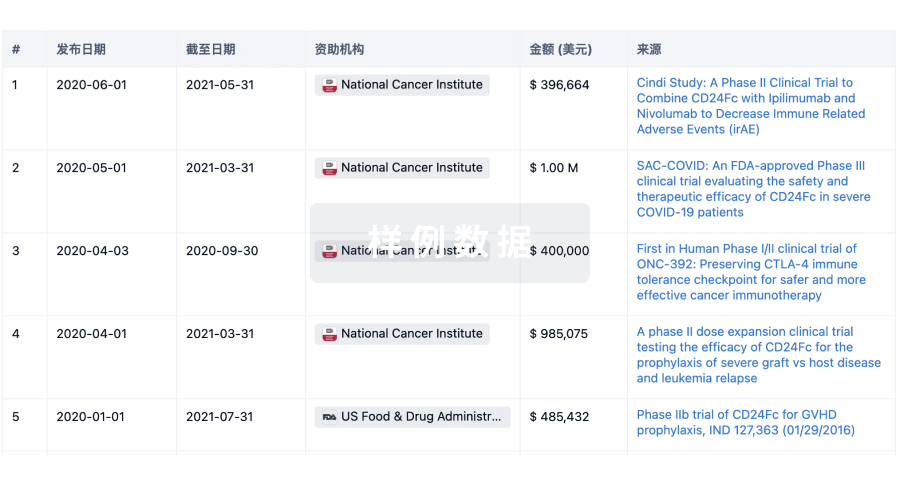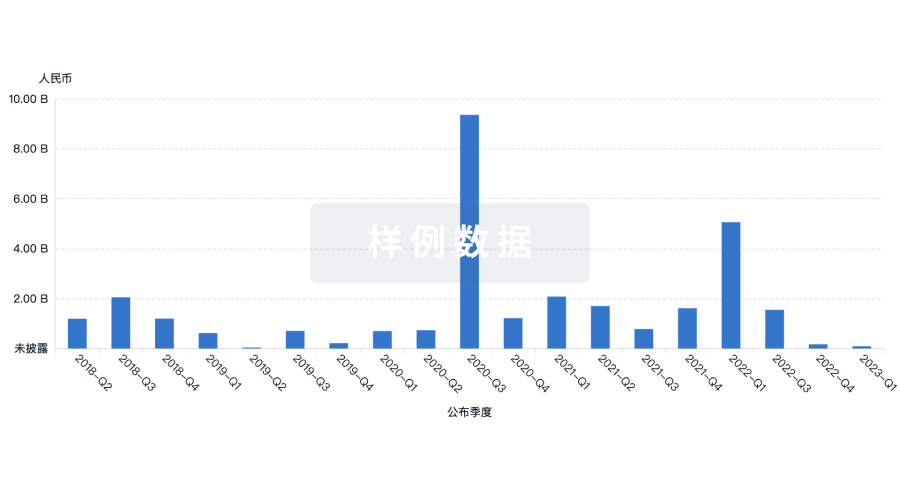预约演示
更新于:2025-09-09

Tianjin University of Traditional Chinese Medicine
更新于:2025-09-09
概览
标签
肿瘤
消化系统疾病
心血管疾病
小分子化药
中药
单克隆抗体
疾病领域得分
一眼洞穿机构专注的疾病领域
暂无数据
技术平台
公司药物应用最多的技术
暂无数据
靶点
公司最常开发的靶点
暂无数据
| 排名前五的药物类型 | 数量 |
|---|---|
| 小分子化药 | 6 |
| 中药 | 4 |
| 未知 | 3 |
| 化学药 | 1 |
| 外泌体药物 | 1 |
| 排名前五的靶点 | 数量 |
|---|---|
| POSTN(periostin) | 1 |
| PD-1(细胞程序性死亡-1) | 1 |
| IL-17A(白细胞介素-17A) | 1 |
关联
16
项与 天津中医药大学 相关的药物靶点 |
作用机制 POSTN抑制剂 |
在研机构 |
原研机构 |
非在研适应症- |
最高研发阶段批准上市 |
首次获批国家/地区 中国 |
首次获批日期2020-03-07 |
185
项与 天津中医药大学 相关的临床试验ITMCTR2025000598
A Cross-over Randomized Controlled Study on the Dose-Effect Relationship of the Cerebral Effect of Acupuncture at Weizhong Point (BL40) in Patients with Lower Limb Motor Dysfunction after Cerebral Infarction
开始日期2025-07-01 |
申办/合作机构 |
ITMCTR2025001028
The Efficacy and Safety of Human-AcuRobot Collaborative Operation for Knee Osteoarthritis Stress Urinary Incontinence and Stroke Hemiplegia: A pilot single-centred study
开始日期2025-06-08 |
申办/合作机构 |
ITMCTR2025000802
Randomized controlled trial on the efficacy of Qingxin Formula in treating chemotherapy-induced cardiac toxicity
开始日期2025-05-01 |
申办/合作机构 |
100 项与 天津中医药大学 相关的临床结果
登录后查看更多信息
0 项与 天津中医药大学 相关的专利(医药)
登录后查看更多信息
5,775
项与 天津中医药大学 相关的文献(医药)2026-01-01·SPECTROCHIMICA ACTA PART A-MOLECULAR AND BIOMOLECULAR SPECTROSCOPY
Heterogeneity of serum metabolism in patients with myeloproliferative neoplasms and acute myeloid leukemia: A Raman spectroscopy study
Article
作者: Xue, Mei ; Wang, Han ; Wang, Haoyu ; Sun, Fanfan ; Liang, Haoyue ; Zhou, Yuan ; Ren, Yansong ; Li, Yihan
In recent years, Raman spectroscopy analysis of hematological diseases is increasingly applied in research, but its application in serum analysis of myeloid neoplastic diseases represented by myeloproliferative neoplasms (MPN), myelodysplastic/myeloproliferative neoplasms (MDS/MPN), and acute myeloid leukemia (AML) has not been fully tested. To establish an oversimplified non-invasive serum test approach for MPN, MDS/MPN and AML, we systematically examined peripheral blood serum samples from 8 patients diagnosed with MPN, 4 patients with MDS/MPN, 3 patients with AML, and 9 control participants. A laser Raman spectroscopy was utilized together with orthogonal partial least squares discriminant analysis (OPLS-DA). Next, a differentiation model for MPN, MDS/MPN, AML, and the control was constructed. Compared with the healthy participants, the serum spectral data of patients with myeloid tumors were specific, and the intensities of Raman peaks representing nucleic acids (786, 1579 cm-1), proteins (643, 759, 1031, 1260, 1603, 1616 cm-1), lipids (1437, 1443, 1446 cm-1), and β-carotene (957 cm-1) were significantly decreased, while the intensity of the Raman peak representing collagen (1345 cm-1) was significantly increased. Metabolic serum marker analysis revealed consistent patterns across MPN, MDS/MPN, and AML patients: adenosine deaminase (ADA) levels were significantly elevated, while both total protein and low-density lipoprotein concentrations showed marked reductions compared to controls. This provides spectroscopic evidence that will guide early differentiation of massive serum test data of patients with MPN, MDS/MPN and AML, and simultaneously uncovers crucial details for rapid and rudimentary differentiating them. This exploratory study show that the Raman spectroscopy analysis is an innovative non-invasive clinical instrument for the detection of MPN, MDS/MPN and AML.
2026-01-01·JOURNAL OF ETHNOPHARMACOLOGY
Integrating network pharmacology, pharmacokinetics and experimental validation to reveal the potential mechanism of Physochlaina physaloides (L.) G. Don in chronic atrophic gastritis
Article
作者: Wei, Wei ; Chang, Yanxu ; Wang, Rui ; Meng, Xue ; Li, Jin ; Zhu, Bihe ; Liu, Yang ; Fang, Shiming ; Du, Kunze
ETHNOPHARMACOLOGICAL RELEVANCE:
Physochlaina physaloides (L.) G. Don, abbreviated as P. physaloides, is a traditional folk medicine, has been extensively utilized for alleviating inflammatory response in gastrointestinal tract. Recent research on P. physaloides has predominantly focused on the identification and isolation of chemical components, but there is a scarcity of studies that discover active ingredients and explore mechanism of action.
AIM OF THE STUDY:
Our research was aimed at identifying the bioactive constituents of P. physaloides, and clarify their potential mechanisms for treating chronic atrophic gastritis (CAG).
MATERIALS AND METHODS:
A "bioactive constituent-core target-key pathway" network was constructed to predict the underlying therapeutic targets of P. physaloides in the therapy of CAG. The association between the bioactive constituent and its corresponding target was substantiated through molecular docking analysis. An efficient and versatile UHPLC-MS/MS method was formulated and verified to quantify the bioactive constituent across multiple biological matrices among rats. Furthermore, the MNNG-induced CAG cellular model and rat model were established. The pharmacological effects of the bioactive constituent were investigated using CCK-8 assays, invasion assays, migration assays, flow cytometry, H&E staining, ELISA kit and Western blot.
RESULTS:
The 47 compounds were found to interact with 1892 corresponding targets, among which 217 disease-associated targets specifically related to CAG were recognized. Among these, physochloside D demonstrated potential binding affinity with STAT3 and JAK2, respectively. Pharmacokinetics and excretion studies in rats revealed that physochloside D is rapidly absorbed but exhibits low bioavailability, undergoing a high degree of biotransformation in vivo. it was indicated that physochloside D effectively mitigates MNNG-induced damage to GES-1 cells and attenuates gastric mucosal atrophy. Furthermore, physochloside D modulates the JAK2/STAT3 signaling pathway, thereby suppressing apoptosis and intestinal metaplasia. Therefore, the development of CAG was hindered.
CONCLUSION:
Overall, this research demonstrated that P. physaloides holds potential as a promising therapeutic agent for CAG. As a specific suppressor of the JAK2/STAT3 signaling pathway, physochloside D is the primary active constituent, which is regarded as a compelling contender for CAG therapy.
2026-01-01·PHYTOCHEMISTRY
Phenolic compounds with anti-neuroinflammatory activities from the heartwood of Caesalpinia sappan L. (Sappan Lignum)
Article
作者: Zhang, Qing-Ying ; Zeng, Ke-Wu ; Guo, Yang ; Wang, Qi-Qi ; Ye, Feng ; Qin, Guo-Qing ; Zhao, Ming-Bo ; Liu, Xiang-Yang ; Tuerhong, Maisuti ; Tu, Peng-Fei
Caesappanols G-Q (1-11), eleven undescribed phenolic compounds, including seven homoisoflavans and derivatives (1-7), two protosappanins (8-9), one phenylacylphenol (10), and one chalcone (11), along with nine known compounds (12-20), were isolated from Sappan Lignum, the heartwood of Caesalpinia sappan L. Structural elucidation of these compounds was accomplished through a combination of 1D and 2D NMR spectroscopy, mass spectrometry, NMR calculations, and ECD calculations. Furthermore, the anti-neuroinflammatory potential of these compounds was assessed by measuring their ability to inhibit NO production. All isolated compounds exhibited inhibitory effects on NO production in LPS-induced BV-2 cells. Among them, compounds 18, 19, and 20 demonstrated the most potent activity, with IC50 values of 19.63, 15.84, and 11.01 μM, respectively.
148
项与 天津中医药大学 相关的新闻(医药)2025-08-11
·美通社
上海
2025年8月11日
/美通社/ -- 2025年8月4-6日,国家中药材标准化与质量评估创新联盟组织专家(以下简称"联盟"),对和黄药业及其战略合作伙伴吉聚参业申报的人参基地进行了现场核查。
现场核查专家组由黑龙江中医药大学孟祥才教授、中国医学科学院药用植物研究所宋经元研究员、天津中医药大学高级会计师王春艳组成,孟祥才教授担任组长。联盟吉林工作站副站长邸鹏、联盟秘书处王国蕴参与核查。通化市农业局主任张玉栋,吉聚参业总经理王桂秋、质量负责人李春艳、基地负责人赵金波,和黄药业高级信息技术和药材资源总监金永芬等陪同核查。
为保障人参药材的卓越品质并从源头筑牢药材质量防线,和黄药业与吉林省"农业产业化省级重点龙头企业"吉聚参业构建了深度协同的战略合作伙伴关系。吉聚参业位于长白山南麓的"中国人参之乡"——集安市清河镇。该地凭借82%的森林覆盖率、湿润气候与富含腐殖质的土壤,为人参生长提供了得天独厚的生态环境。双方基于"共建共享"模式,共同推进人参规范化种植基地建设,成功贯通了从种植、初加工到销售的完整产业链,有力支撑了和黄药业对高品质、可溯源人参药材的持续需求,有效提升了供应链的稳定性和韧性。
核查期间,专家组实地考察了药材加工车间和仓储设施。加工车间配备了先进的温控烘干设备,可精准控制温度用于干燥人参,确保人参有效成分不流失;仓储设施采用智能温湿度控制系统,实时监测并调节环境,保障药材存储安全。同时,专家组听取了工作人员关于人参加工工艺流程、药材存储方式、防虫防霉变的管理措施等方面汇报,全面了解了人参加工和储存环节。
随后,专家组前往人参种植基地进行考察,听取关于基地建设、种子质量控制、人参种植、病虫害防治及农药肥料的使用等方面汇报,深入了解了人参种植的全过程。
验收会上,企业人员汇报了企业基本情况、基地建设模式及规模、质量管控体系、"无硫加工、无真菌毒素污染、无公害"的生产技术及管控、溯源体系实施情况、人参生产技术及企业发展规划等。专家组按照联盟"三无一全"(无硫加工、无黄曲霉素污染、无公害及全过程可追溯)现场核查要求,对人参基地的土地承包协议、文件体系、生产记录、药材质检报告和基地环境评价报告等进行审查,确保申报材料的有效性、准确性和真实性。
通过现场考察和资料审核,专家组对人参基地管理的规范性、加工和仓储设施的先进性、人员配置的合理性、生产过程的可追溯性、发展的可持续性等给予高度认可;同时建议吉聚参业做好人参的良种选育工作及精深产品开发,从而提升人参产品的多样性。
近年来,和黄药业持续聚焦重点产品麝香保心丸和胆宁片的组方药材,通过自建或合作共建模式,在道地产区科学布局规范化药材种植基地,对药材实施全流程精准管控,从根本上确保原药材质量的稳定性与可控性。截至目前,麝香保心丸原料人参及肉桂已100%实现溯源,胆宁片7味药材全面达成100%可溯源,为优质药材的稳定供给筑牢了根基。与此同时,公司积极布局动物药基地建设,越来越多的养殖户加入蟾蜍养殖行列。未来,和黄药业将持续以科技赋能基地发展,不断推进药材基地规范化与标准化建设,为中药高质量发展注入核心驱动力。
高管变更
2025-07-21
·梅斯医学
20日晚间,甘肃省委省政府调查组已发布关于天水市麦积区褐石培心幼儿园幼儿血铅异常问题调查处置情况的通报。对省卫生健康委党组书记、主任,省卫生健康委党组成员、副主任、省疾控局局长,天水市委书记,天水市委副书记、市长,天水市委常委、秦州区委书记(时任麦积区委书记),天水市政府分管教育、卫生健康工作的副市长,天水市政府分管市场监管工作的副市长,天水市麦积区委书记,天水市麦积区委副书记、区长,天水市麦积区政府分管教育、卫生健康、市场监管工作的副区长等10人立案问责。血铅检测问题涉及的天水市第二人民医院和甘肃省疾病预防控制中心一把手“火速”换人。甘肃省疾控中心“一把手”火速换人,7人被立案!据甘肃省卫健委,2025年7月20日下午,甘肃省疾病预防控制中心召开干部大会,宣布张廷生同志任甘肃省疾病预防控制局党组成员、副局长,甘肃省疾病预防控制中心党委书记、主任。据澎湃新闻,张廷生,男,汉族,1980年11月出生,甘肃礼县人,中共党员,大学学历,医学学士。此前担任甘肃酒泉市委卫生健康工委副书记、市卫生健康委党组副书记、主任,上海市第一人民医院酒泉医院(酒泉市人民医院)党委书记。甘肃省疾控中心官网截图此外,甘肃省疾控中心前党委书记王文军、前主任孙建云的简历已从官网撤下。据20日甘肃省委省政府调查组发布《关于天水市麦积区褐石培心幼儿园幼儿血铅异常问题调查处置情况的通报》,甘肃省疾控中心在接受该重大紧急任务后,没有引起重视,组织管理不力,主要负责人简单随意安排血铅检测工作,检测人员严重违反操作规程,导致检测结果严重失真。后又通过多种方式逃避责任、阻碍调查。调查提到,纪检监察机关已对该中心党委书记王文军、主任孙建云、理化实验室主任李拥军等7人立案审查调查。天水市第二人民医院被全面托管据甘肃省卫健委通报,为全面提升天水市第二人民医院医疗卫生服务水平,由甘肃省人民医院全面托管天水市第二人民医院,省人民医院原党委书记、主任医师李兴勇担任天水市第二人民医院党委副书记、院长。李兴勇,男,1963年8月生,中共党员,毕业于兰州医学院医疗系,医学硕士,骨科主任医师,天津中医药大学硕士研究生导师,甘肃中医药大学博士研究生导师,甘肃省政府参事,享受国务院特殊津贴专家、甘肃省五一劳动奖章获得者。同时,选派省人民医院普外科主任医师何锦担任天水市第二人民医院党委副书记、副院长,选派36名儿科、中毒治疗、消化、心理卫生、检验等省级专家长期入驻天水市第二人民医院开展诊疗服务。此前调查认为,天水市第二人民医院及其检验科管理混乱,岗位职责落实不到位,实验室质量控制执行不到位,相关检验人员缺乏系统性培训,该复检的未复检且直接修改检验结果,严重违反职业操守,严重违反《医疗机构管理条例实施细则》《医疗机构临床实验室管理办法》《血铅临床检验技术规范》《医疗机构从业人员行为规范》等相关规定。调查还发现,该院检验科此前也存在违规修改血铅检验数据的问题,纪检监察机关正在深入调查中。据了解,天水市第二人民医院已重新购置国内最新的血铅检验设备。目前已完成设备安装调试、计量检定、比对验证和人员培训,3名省级检验专家入驻开展血铅检验工作,具备快速准确进行血铅检验的能力。撰文 | 木白编辑 | 木白●广东发生一级甲等事故,16岁男孩胃肠疾病住院,医院延误手术导致死亡!省市两级鉴定结果相反,该听谁的?医生没有把握,就该及时转院●“暴力”减肥后体重反弹之谜被破解?Nature连发两篇:胖过一次,身体就会“铭记”;且减肥后促炎巨噬细胞持续潜伏,引爆体重反弹● 震撼!8年制医学博士都难找工作,无奈去社培!名校博士:今年医院岗位少,连母校也不要我!以前博士年薪动辄百万,现在20万就满足了?版权说明:梅斯医学(MedSci)是国内领先的医学科研与学术服务平台,致力于医疗质量的改进,为临床实践提供智慧、精准的决策支持,让医生与患者受益。欢迎个人转发至朋友圈,谢绝媒体或机构未经授权以任何形式转载至其他平台。点击下方「阅读原文」 立刻下载梅斯医学APP!
高管变更
2025-07-21
据新天水客户端消息,为全面提升天水市第二人民医院医疗卫生服务水平,由甘肃省人民医院全面托管天水市第二人民医院,省人民医院原党委书记、主任医师李兴勇担任天水市第二人民医院党委副书记、院长。李兴勇,男,1963年8月生,中共党员,毕业于兰州医学院医疗系,医学硕士,天津中医药大学硕士研究生导师,甘肃中医药大学博士研究生导师,省政府参事,享受国务院特殊津贴专家、甘肃省五一劳动奖章获得者。同时,选派省人民医院普外科主任医师何锦担任天水市第二人民医院党委副书记、副院长,选派36名儿科、中毒治疗、消化、心理卫生、检验等省级专家长期入驻天水市第二人民医院开展诊疗服务。另据了解,天水市第二人民医院重新购置国内最新的血铅检验设备。目前已完成设备安装调试、计量检定、比对验证和人员培训,3名省级检验专家入驻开展血铅检验工作,具备快速准确进行血铅检验的能力。另据澎湃新闻消息,7月20日下午,甘肃省疾病预防控制中心召开干部大会,宣布张廷生同志任甘肃省疾病预防控制局党组成员、副局长,甘肃省疾病预防控制中心党委书记、主任。张廷生张廷生,男,汉族,1980年11月出生,甘肃礼县人,中共党员,大学学历,医学学士。公开资料显示,他此前担任甘肃酒泉市委卫生健康工委副书记、市卫生健康委党组副书记、主任。就在7月20日,甘肃省委省政府调查组通报了天水市麦积区褐石培心幼儿园幼儿血铅异常问题调查处置情况。其中提到,经调查确认,7月2日至3日,褐石培心幼儿园血铅检测由甘肃省疾控中心承担。调查发现,甘肃省疾控中心在接受该重大紧急任务后,没有引起重视,组织管理不力,主要负责人简单随意安排血铅检测工作,检测人员严重违反操作规程,导致检测结果严重失真。后又通过多种方式逃避责任、阻碍调查。调查发现,该中心党委书记王文军、主任孙建云、理化实验室主任李拥军还涉嫌存在其他违纪违法问题。纪检监察机关已对王文军、孙建云、李拥军等7人立案审查调查。澎湃新闻注意到,王文军、孙建云的简历已从甘肃省疾控中心网站上撤下。20日晚间,央视新闻、甘肃省政府发布了天水血铅事件处置情况的通报,其中6人被批捕、17人被立案审查调查、10人被立案问责。思齐俱乐部综合自澎湃新闻、新天水客户端点击 阅读原文了解更多
高管变更
100 项与 天津中医药大学 相关的药物交易
登录后查看更多信息
100 项与 天津中医药大学 相关的转化医学
登录后查看更多信息
组织架构
使用我们的机构树数据加速您的研究。
登录
或

管线布局
2025年09月14日管线快照
管线布局中药物为当前组织机构及其子机构作为药物机构进行统计,早期临床1期并入临床1期,临床1/2期并入临床2期,临床2/3期并入临床3期
药物发现
6
7
临床前
临床2期
3
1
其他
登录后查看更多信息
当前项目
| 药物(靶点) | 适应症 | 全球最高研发状态 |
|---|---|---|
加参片 | 冠心病 更多 | 临床2期 |
三叶片 | 代谢功能障碍相关的脂肪肝病 更多 | 临床前 |
Lyc@GA-Cu Gel | 结直肠癌 更多 | 临床前 |
TY8901 | 肿瘤 更多 | 临床前 |
TY8301 | 多发性骨髓瘤 更多 | 临床前 |
登录后查看更多信息
药物交易
使用我们的药物交易数据加速您的研究。
登录
或

转化医学
使用我们的转化医学数据加速您的研究。
登录
或

营收
使用 Synapse 探索超过 36 万个组织的财务状况。
登录
或

科研基金(NIH)
访问超过 200 万项资助和基金信息,以提升您的研究之旅。
登录
或

投资
深入了解从初创企业到成熟企业的最新公司投资动态。
登录
或

融资
发掘融资趋势以验证和推进您的投资机会。
登录
或

Eureka LS:
全新生物医药AI Agent 覆盖科研全链路,让突破性发现快人一步
立即开始免费试用!
智慧芽新药情报库是智慧芽专为生命科学人士构建的基于AI的创新药情报平台,助您全方位提升您的研发与决策效率。
立即开始数据试用!
智慧芽新药库数据也通过智慧芽数据服务平台,以API或者数据包形式对外开放,助您更加充分利用智慧芽新药情报信息。
生物序列数据库
生物药研发创新
免费使用
化学结构数据库
小分子化药研发创新
免费使用
